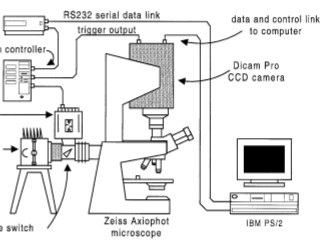High resolution detection of Fuorescently labeled microorganisms in environmental samples using time-resolved Fluorescence microscopy
RUSSELL CONNALLY,1* DUNCAN VEAL,1 AND JAMES PIPER2Abstract
The high level of discrimination offered by fluorescence microscopy has led to its widespread use for the analysis of individual microbial cells. The major limitation of fluorescence microscopy in microbial ecology is that many types of environmental samples contain autofluorescent material that can obscure emission from a fluorescent label. Time-resolved fluorescence microscopy (TRFM) is a technique that greatly reduces background autofluorescence whilst maintaining signal strength of the fluorescent target. TRFM differs from fluorescent microscopy in the use of fluorophores that are characterized by long-lived luminescence. Samples are briefly illuminated to excite fluorescence then capture of luminescence is delayed for a time interval sufficient to ensure autofluorescence has largely faded. TRFM has not been extensively used in microbiology because of the limitations and cost of available time-resolved microscopes and the lack of suitable long-lived fluorescent labels. Here we describe modification of a commercial fluorescence microscope for time-resolved operation through the addition of an image-intensified camera and low cost flashlamp. The TRFM was used in combination with a novel immunofluorophore for the specific detection of Giardia cysts in a water sample containing large amounts of autofluorescent material. A 60-Ws gate delay between excitation and detection resulted in a 30-fold increase in contrast of labeled parasites compared to conventional immunostaining. To our knowledge, this is the first report of the use of TRFM for the detection of microorganisms in environmental samples. 5 2002 Federation of European Microbiological Societies. Published by Elsevier Science B.V. All rights reserved.




